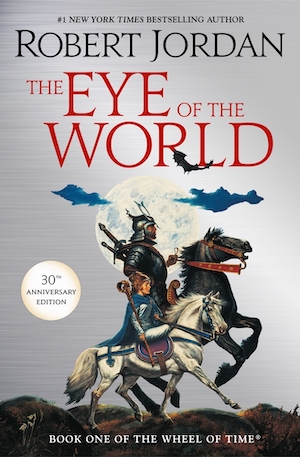They say that if you die in a dream you wake up. This may be true for ordinary, in-your-own-head kind of dreams, but things work a little differently for the World of Dreams, also known as Tel’aran’rhiod. In this plane of existence, where the waking world is echoed in almost perfect replica, a hurt taken shows up on the body of a Dreamer, and dying in Tel’aran’rhiod means never waking up at all.
But despite the fact that there are significant differences between the World of Dreams, which is a place you can visit, and ordinary dreams, which play out in our own minds, you can still find a great deal of parallels between how they function, and a visit to Tel’aran’rhiod can serve some of the same purposes that dreaming does.
Even if the former can also kill you.
Have you ever dreamed you were flying? I used to have that dream all the time, but as I got older the dream got less and less frequent until I stopped having it altogether, and I always wished I could get it back again. In Tel’aran’rhiod Egwene gets to try out flying when she’s scoping out Tanchico. It may not be a wise idea, but, like a lucid dreamer, all she needs is the ability to imagine it—and to be confident.
She wobbled as she thought how ridiculous this was—Flying? People did not fly!—then steadied again as she forced herself to be confident. She was doing it, and that was all there was to it. This was a dream, and she was flying. The wind rushed in her face, and she wanted to laugh giddily. (The Shadow Rising, Chapter 11)
Buy the Book


The Eye of the World: Book One of The Wheel of Time
We saw Perrin struggle early on with the focus and determined sense of self that Tel’aran’rhiod requires, his body changing to the wolf unless he consciously focused on looking like himself. And while Egwene quickly learned the control she needed, Nynaeve still struggles with the fact that stray thoughts in Tel’aran’rhiod can affect her appearance, especially her clothes, and that she can’t willfully manifest what she wants as easily as Egwene or even Elayne can. Someone with a mastery of this focus, however, can even alter other people’s appearance, as we see when Amys and Egwene first encounter each other, and Amys makes Egwene’s clothes disappear.
For a moment she gaped in disbelief, dancing from foot to foot. She had not thought it possible to change things about someone else. So many possibilities, so many rules, that she did not know. Hurriedly she thought herself back into stout shoes and the dark dress with its divided skirts and at the same time made the Aiel woman’s garments vanish. She had to draw on saidar to do it; the woman must have been concentrating on keeping Egwene naked. She had a flow ready to seize the spear if the other woman made to throw it. (The Shadow Rising, Chapter 11)
Like lucid dreaming, the first step to navigating Tel’aran’rhiod seems to be knowing that you’re dreaming. This comes pretty easily to Egwene and Perrin—once they know what Tel’aran’rhiod is they are usually easily able to know when they are there.
It could have been any dream, perhaps, except that he was aware it was a dream. And he knew the feel of the wolf dream, the reality and solidity of it, from the long grass around his boots to the breeze out of the west that ruffled his curly hair, to the scattered ash and hemlock. (The Shadow Rising, Chapter 42)
The technique of holding an image or thought in one’s mind is also used in lucid dreaming, and one technique to make oneself lucid dream, Wake-Initiated Lucid Dreaming, involves going directly from being awake into a dream, which is how arriving in Tel’aran’rhiod seems to work as well. However, Amys is able to trick Egwene into thinking that she is awake when she is in fact still in the Dream World, so the knowledge is not a guarantee.
Scientists don’t actually know why we dream, but there are theories. One theory is that dreaming is a way for our minds to process information, committing our day—its events, its emotions—to memory and filing them neatly away. And memory is also a big part of existing in Tel’aran’rhiod. One must picture where one wants to be in order to arrive there, must hold that picture in their mind. The picture doesn’t have to be exact—Egwene is able to use memorized maps of the Panarch’s Palace to travel to the Tanchico of Tel’aran’rhiod, and she is also able to travel to the Waste just by thinking about a Wise One. Nynaeve, Egwene and Elayne are able to travel to the Heart of the Stone using their memories of the place, despite the fact that it has changed since they were last there—they never saw Rand thrust Callandor into the floor.
This means that they now have complete memories of places that have changed since they last saw them, and places they have never actually been. Tel’aran’rhiod is itself a sort of memory, albeit one that plays out in real time. We see the waking world is echoed in every natural detail, landscape, wild animal. Even buildings and other human structures show up there, as long as they have been in place for some time. But things that do not stay permanently, such as the Tuatha’an’s wagons, leave only a hazy impression, as though Tel’aran’rhiod barely remembers them. Humans, apparently, are just passing through, and only their homes and possessions leave a memory.
Perrin doesn’t seem to have figured out that he can imagine any place and be instantly transported there. So he moves instead to any place he can see from where he currently is, picturing the place he arrives by actually looking at it. But we do see Perrin work through and process his emotions and experiences while he is in Tel’aran’rhiod. Most recently, Perrin’s conscious choice to carry an axe conflicted with his subconscious desire for the hammer, and Tel’aran’rhiod literally reflected that struggle as he tried to change which tool he was carrying.
… [H]e rested a hand on his axe—and looked down in surprise. The heavy blacksmith’s hammer hung in the loop on his belt, not the axe. He frowned; once he would have chosen that way, had even thought he had, but surely no more. The axe. He had chosen the axe. Hammerhead suddenly became half-moon blade and thick spike, flickered back to stout cylinder of cold steel, fluttered between. Finally it stopped, as his axe, and he exhaled slowly. (The Shadow Rising, Chapter 42)
But past information isn’t the only thing we may be processing when we dream. We may also be preparing for the future, running possible scenarios so that when we face them in real life, we are more prepared to handle ourselves. Tel’aran’rhiod also offers this the ability to prepare for the future and try out scenarios—Elayne tries on the Sea Folk garb, for example, in a place where no one can see her and the clothes aren’t even real.
“It is how the Sea Folk women dress at sea,” she said hurriedly, with a furious blush. “I wanted to see how it felt, and this seemed the best place. I couldn’t do it on the ship, after all.” (The Shadow Rising, Chapter 35)
More seriously, Egwene uses Tel’aran’rhiod to search for evidence of the Black Ajah, and Perrin discovers that the Waygate has been reopened by traveling there in the Wolf Dream. Dreaming can also be used to see possible futures, according to the Wise Ones, which perhaps suggests that they test scenarios and observe their outcomes within the Dream, then use the resulting information to predict how things will go in the waking world. Or perhaps sometimes Tel’aran’rhiod remembers things that haven’t happened yet in the waking world—time in dreams is a funny thing, and can stand still or skip as far as Perrin’s miles-long strides.
Our dreams can also provide things we’re missing. Dream psychologists have reported an uptick in people dreaming of spending time with loved ones during times of isolation, like the one we are all going through now, and dreamers are especially likely to recall memories from years past, or even their childhood. Though dreaming of a vacation you can’t take again or a person you can’t hug right now can be frustrating, it can also sometimes be a happy dream that provides a bit of joy, a bit of healing, as it gives our brains a taste of the social connection we are missing. And just as we may dream of loved ones we’ve lost, or that we are with friends who live far away, traveling to Tel’aran’rhiod allows Egwene to stay in touch with Nynaeve and Elayne, despite the physical distance between them, and Perrin is able to visit with his friend Hopper, for whom the Dream World is an actually afterlife.
How wonderful to go to sleep and spend time with people we love, even when they are far away or lost to us.
In the end, Tel’aran’rhiod is a place. It is a place shaped by the echoes of Creation perhaps, or as I suggested before, its memory. But echos and memories have much to teach us, and so they reside in our thoughts and our psychology as something more than locations. They are a part of how we think, and who we are, and a knowledgeable Dreamer, I think, must always remember that.
Sylas K Barrett still has a lot to learn about Tel’aran’rhiod, so some aspects of his analysis may change as he reads. But mostly, he thinks he’s got a sense of things, kind of like how Elayne has great potential, but a lot to learn. He looks forward discovering more.










